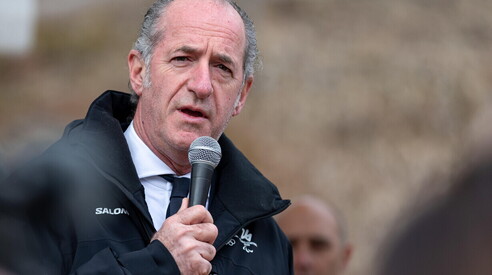Zaia's List for Dummies: Figures, Faces, and Battles of the Doge's Army


Ansa photo
in Veneto
The potential emergence of a new "Zaia List" is troubling the Veneto center-right. The goal is to revive the governor's legacy and broaden support beyond the League's borders.
On the same topic:
We're taking to the field. Or at least preparing: ever since Matteo Salvini —even he, caught up in his own wonderful work on the Strait of Messina—opened up to the possibility of a Zaia list, the Veneto has been talking about nothing else. It's the legacy that must be defended, protected, and relaunched. All in the name of the president. The next Zaia list will have to be different from the past, but it will still start from certain profiles of certain political and administrative loyalty. Province by province. In the Treviso area, the governor's historic stronghold, Alberto Villanova, leader of the Zaia group in the Council, will be the one to draw the cards. Along with him, Sonia Brescacin, both of whom received over 8,000 votes in the last round of voting. Zaia's other heir apparent is in Verona: regional vice president Elisa De Berti. She received 5,000 votes. Other key figures include Councilor Francesco Calzavara in Venice, Laura Cestari in Rovigo, and Giovanni Puppato in Belluno. Meanwhile, in Padua, where the contest has the feel of a boxing ring—it's the stronghold of Salvini's parliamentarians, but also of the wildly popular Roberto Marcato, tempted by a solo run—Zaia is relying on the civic-mindedness of Elisa Cavinato. Finally, there's no doubt in Vicenza: Roberto Ciambetti, president of the Regional Council, and Health Councilor Manuela Lanzarin are from there. They each received 10,000 votes. In total, a handful of Zaia List members would be enough to once again surpass the 50,000 mark . A full coterie, and the Veneto region has been warned.
What exactly is the list that would shake the Brothers of Italy and Forza Italia—and even the League itself—if it were to participate in the elections? Spoiler alert: at this point, not even Zaia knows. Yet, all it takes is breaking the news. A round of phone calls. And from morning to night, more new names would knock on the door than the list could possibly accommodate. Civic figures, League members, business leaders. Starting with the superpower of the outgoing Regional Council. In any case, everyone knows: without Zaia as a candidate, it will be impossible to repeat the 2020 feat. A triumph with over 76 percent. The governor's list is at nearly 45 percent: translated, 23 out of 49 councilors elected. Plus another nine from the League, hijacked by the Doge's overflowing electoral machine. Today, he claims that his future list would broaden its support base, gaining votes from the left as well—remember the battle over end-of-life issues—and among abstentions. The latest polls put her at around 30 percent, leading the entire center-right. The logic of good governance, above ideology. Good. If that were the case, however, the current structure would need to be revamped. Because all the candidates on Zaia's list, in 2020, also held League membership cards. And many of them—from Bottacin from Belluno to Centenaro from Padua—obtained their seats thanks to their hard-line Lega Nord. Some others had more secular experience, but they never denied the Leone di San Marco-Alberto da Giussano partnership.
Zaia's list will not be able to re-present itself in this way, first and foremost because the other parties—FdI in the lead—will not allow a duplicate Northern League candidate to appear in disguise. So what will become of those 23? Some have already fled to other shores: the pro-Russian Valdegamberi and the resurgent Barbisan—expelled from the League for racist remarks on TV, then quietly reinstated—have relocated to the mixed group as per pre-election agreements; Fabrizio Boron quickly joined Forza Italia, and Silvia Rizzotto joined FdI a few months ago. Furthermore, several outgoing councilors are reportedly stepping down spontaneously for personal reasons or seniority. If Rome actually gives the green light, it will be that one day not so far away, Zaia and Alberto Stefani, Salvini's trusted regional secretary, will sit down and take stock of the situation, municipality by municipality. Evaluating industrial profiles, local figures, and local activists without labels. Stefani himself has been pushing for months to open the doors of the struggling League to civic engagement. With Zaia as a spokesperson, the move would be vote-proof. Word has now spread: behind the scenes and before the eyes of the Venetians, the president's unparalleled aura will not wane. Not today, not tomorrow.
More on these topics:
ilmanifesto





